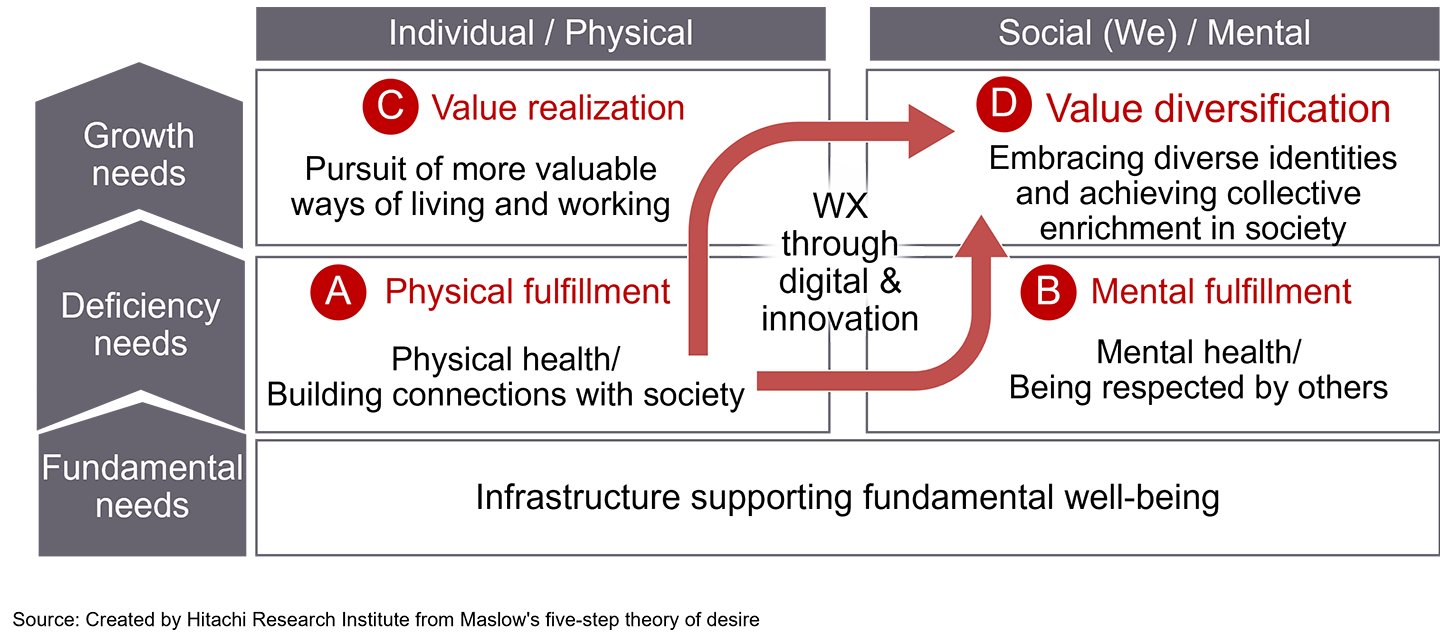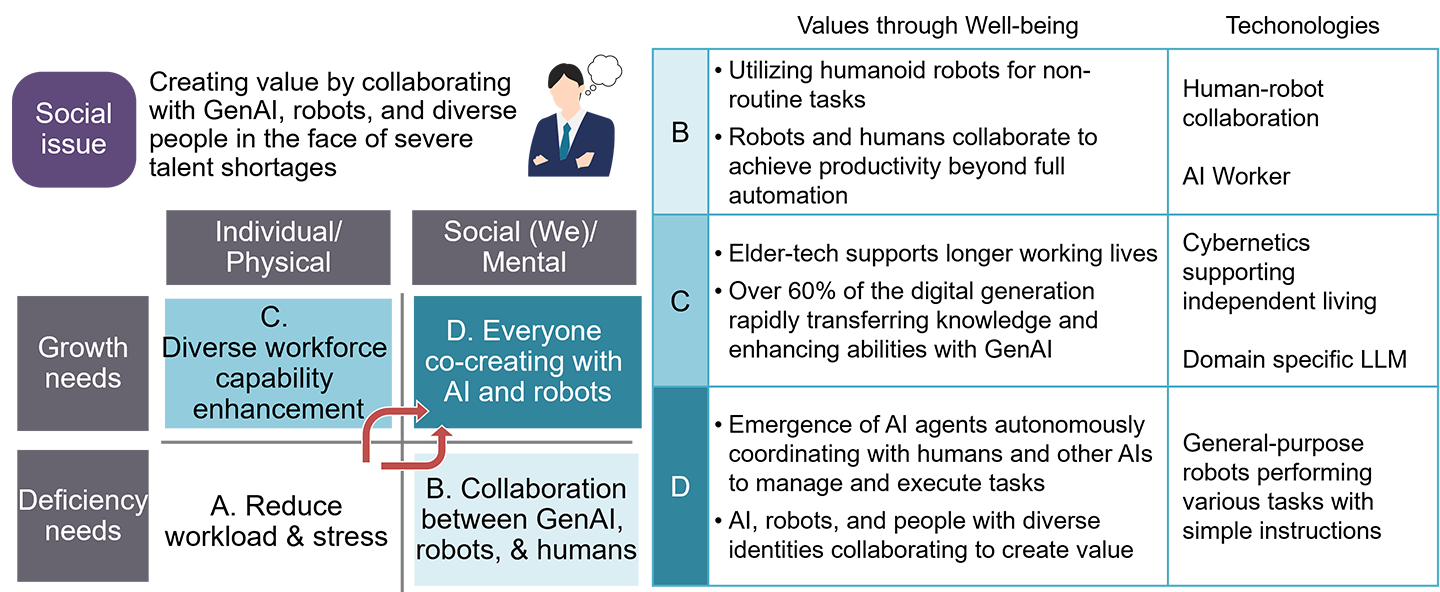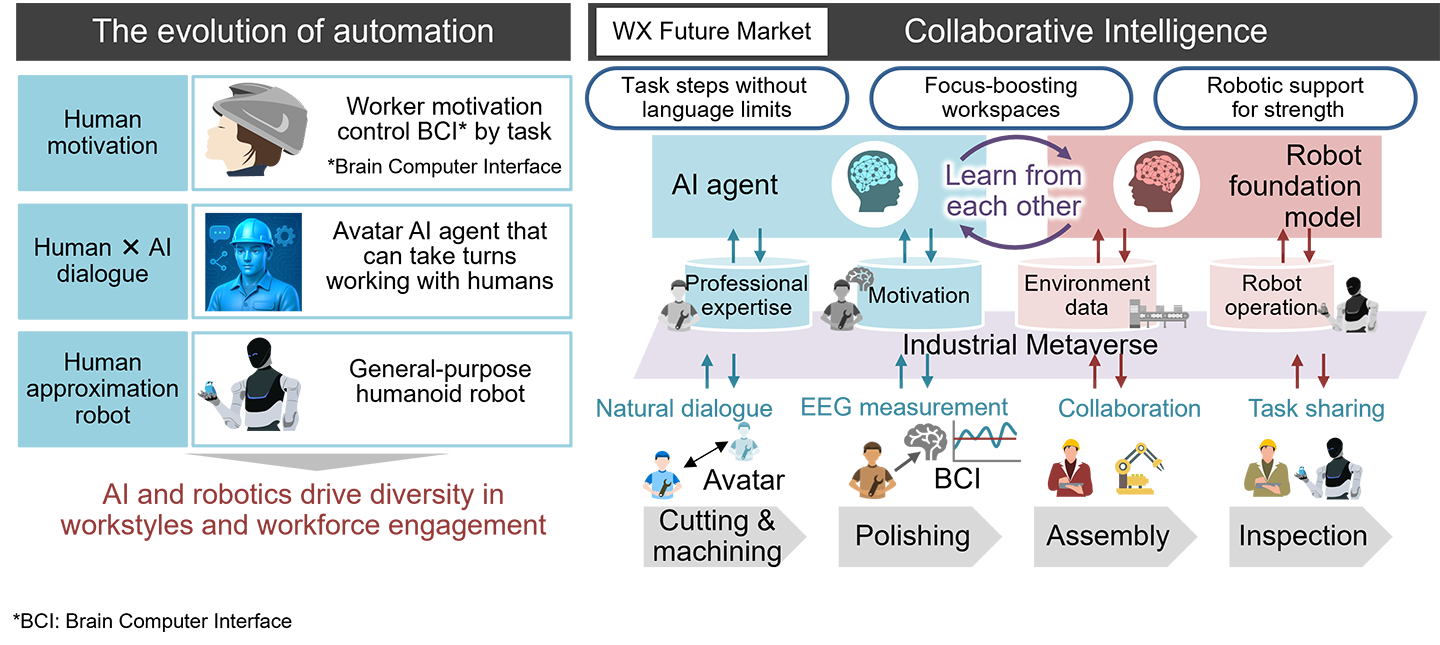Nov. 19, 2025
This research focuses on Well-Being Transformation (WX) as an emerging trend in social change, following in the footsteps of Digital Transformation (DX) and Green Transformation (GX).WX is a concept that aims to restructure industries and businesses through the lens of human well-being—that is, the pursuit of a better quality of life—in response to rapid advances in generative AI and the increasing diversity of values. It addresses well-being from three perspectives: “Physical and Mental,” “Workstyle,” and “Social Life” (Figure 1). In this report, we focus on the theme of “Workstyle,” examining: the emerging social challenges that necessitate WX, the possible directions in which well-being may evolve, and how next-generation technologies can be harnessed to reshape industries and businesses.

Source:Prepared by Hitachi Research Institute
Figure 1. Concept of Well-Being Transformation (WX)
At Hitachi Research Institute, we view WX as a process that will unfold in distinct stages. As illustrated in Figure 2, these stages can be categorized along two axes: the vertical axis representing human needs, and the horizontal axis representing scope—ranging from individual and physical aspects to social (“We”) and psychological dimensions. At the foundation lies the infrastructure that supports basic well-being, the ability to live in safety and security. To satisfy unmet needs, people pursue (A) physical fulfillment, such as maintaining bodily health and social connections, and (B) mental fulfillment, such as mental health and the feeling of being respected by others. Beyond this, they seek (C) value realization through more meaningful ways of living and working. Finally, society advances toward (D) value diversification, where individuals with diverse identities are accepted, and collective prosperity is pursued. We believe that the emergence of new technologies and businesses aligned with these stages (A–D) will enable WX through digital & innovation (Figure 2).

Source:Prepared by Hitachi Research Institute
Figure 2. The Evolution of Well-Being Concepts
Labor shortages are becoming increasingly severe across a wide range of occupations—from factory workers to researchers and service staff—due to declining working populations and mismatches in skills and roles. Chronic shortages place heavier burdens on existing employees, which in turn leads to resignations caused by physical and mental strain, creating a vicious cycle of further labor scarcity*1.
Automation and labor-saving technologies powered by AI and robotics are expected to help address this shortage, with generative AI in particular advancing and spreading rapidly. At the same time, however, concerns over job displacement due to generative AI are growing. By 2025, major U.S. tech companies such as Amazon and Microsoft had already begun announcing workforce reductions numbering in the thousands. In China, demonstration tests involving the unmanned operation of large cargo aircraft are underway, indicating that AI adoption is becoming increasingly common—even in highly specific fields.
Thus, while AI plays a key role in addressing labor shortages, it also heightens concerns about the displacement of human labor. In this never-before-seen labor environment, redefining “Workstyle” has become more important than ever.
When considering the future of well-being in the domain of “Workstyle,” the traditional focus has been on reducing individual workloads (Figure 3A). Moving forward, however, progress will involve not only collaborating with the increasing presence of AI and robots (Figure 3B), but also maintaining and enhancing human capabilities (Figure 3C). Ultimately, the goal is to create a world where people and AI/robots work together to co-create high value (Figure 3D).

Source:Prepared by Hitachi Research Institute
Figure 3. The Progression of Well-being in Workstyle
Collaboration with AI and robots, as represented by Domain B, is not limited to physical labor in environments like factories and warehouses. In office settings, AI agents are also starting to play an important role. These systems can carry out tasks on their own once a goal is set, without needing detailed instructions from humans. As a result, “AI workers” are becoming common partners in office work. Some predict that, within the next few years, startups could achieve $1 billion in revenue with only a handful of human employees and AI workers*2.
In domain C, advances in elder-tech and cyborg technologies will help individuals maintain and even enhance their capabilities, regardless of age or physical limitations. For example, experienced workers may offset age-related physical decline by wearing cyborg suits, allowing them to stay active in the workforce longer. At the same time, less experienced workers will be able to acquire skills more quickly. Domain-specific large language models (LLMs) can offer interactive, multimodal on-the-job training, replicating traditionally tacit or embodied knowledge at the task level. As a result, novices can reach full proficiency in a fraction of the time previously required.
In domain D, as general-purpose AI and robots continue to advance, robots will gain the ability to perceive their surroundings autonomously and perform tasks flexibly based on simple human instructions. For example, Figure AI, a U.S.-based company, has developed the Helix model—an integrated Vision-Language-Action system that combines visual perception, natural language understanding, and control capabilities. In a public demo, a person handed shopping bags to a household robot and asked it to put away the groceries in the refrigerator and pantry; the robot successfully completed the task.
Through this kind of collaboration between humans, AI, and robots, individuals will be liberated from physical limitations and constraints of prior experience. People will be empowered to fully leverage their unique traits and capabilities, realizing personal fulfillment by generating meaningful, high-level contributions.
As technological advances and widespread adoption continue to reshape “Workstyle,” new modes of labor—where humans collaborate with AI and robots—are becoming increasingly viable. This section examines how industries and businesses could be restructured through WX.
As of 2025, emerging technologies include brain–computer interfaces (BCIs) that detect worker fatigue and motivation to support stress reduction and sustained concentration through neural stimulation; avatar AI agents that can share tasks with humans while interacting through enterprise systems; and general-purpose humanoid robots capable of performing various tasks (Figure 4, left).
When these individual technologies are integrated, the co-evolution of humans, AI, and robots can be achieved.
For example, in a manufacturing environment, AI agents can collect and learn from both the tacit knowledge of skilled workers and motivation-related data from on-site personnel, effectively converting implicit expertise into explicit knowledge. A robotic foundation model—pre-trained on large-scale datasets, including AI agent analyses—can then use factory conditions and machine operation data as input to enable swarm control, helping create an environment where humans can work with greater focus and efficiency.
By enabling real-time information sharing, communication, and task coordination among humans, AI agents, and robots, each can contribute their unique strengths. This leads to both increased productivity and improved well-being. In practice, this means that tasks can be assigned without being constrained by language barriers or previous experience. At the same time, work environments are designed to help individuals concentrate, and robots provide support that amplifies each worker’s strengths. As a result, new forms of industrial operations are emerging in which humans, AI, and robots collaborate and evolve together (Figure 4, right).

Source: Prepared by Hitachi Research Institute
Figure 4. Co-evolution of Humans × AI × Robots
This research focuses on WX as the next major wave of social change following DX and GX. Taking a human-centered perspective, WX reconsiders the dimensions of Physical and Mental, Workstyle, and Social Life, offering a new framework for restructuring industries and businesses. While Hitachi Research Institute has been analyzing specific challenges and technological trends across all three well-being domains, this article focuses on "Workstyle" as a case study to explore how WX might reshape industries and businesses.
Going forward, we will continue to explore the latest technologies and trends related to well-being, while examining how industries and businesses may be reshaped by WX and how Hitachi can contribute to this transformation.

Masayasu Watanabe
Senior Researcher, Technology Strategy Group, 3rd Research Department, Hitachi Research Institute
Previously with Boston Consulting Group and Mitsubishi UFJ Research & Consulting before joining Hitachi.
His recent research themes include the industrial and societal transformation driven by advances in AI and the evolution of the system integration business.

Hiroshi Nishimura
Associate Senior Researcher, Industry Research Group, 3rd Research Department, Hitachi Research Institute (at the time of writing).
After engaging in manufacturing and supply chain DX and technology strategy development at Hitachi Research Institute, he currently works at Hitachi High-Tech Corporation.
His primary research themes include biotechnology, green transformation (GX), regional economies, and generative AI.
Author’s Introduction

Masayasu Watanabe
Senior Researcher,
3rd Research Department,
Hitachi Research Institute

Hiroshi Nishimura
Associate Senior Researcher,
3rd Research Department,
Hitachi Research Institute
We provide you with the latest information on HRI‘s periodicals, such as our journal and economic forecasts, as well as reports, interviews, columns, and other information based on our research activities.
Hitachi Research Institute welcomes questions, consultations, and inquiries related to articles published in the "Hitachi Souken" Journal through our contact form.